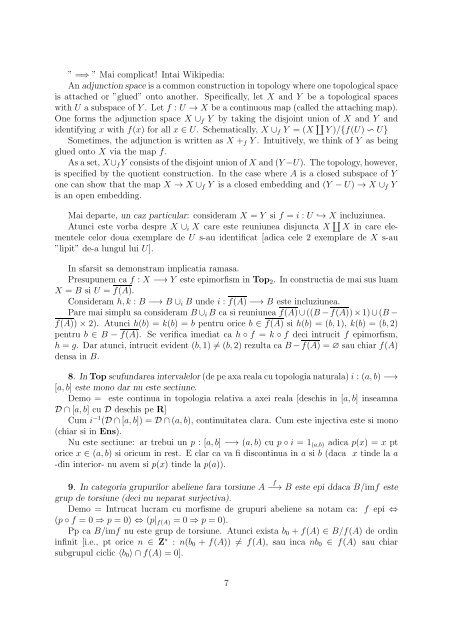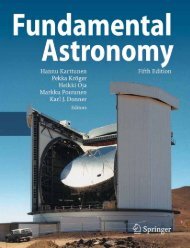Create successful ePaper yourself
Turn your PDF publications into a flip-book with our unique Google optimized e-Paper software.
” =⇒ ” Mai complicat! Intai Wikipedia:<br />
Anadjunctionspaceisacommonconstructionintopologywhereonetopologicalspace<br />
is attached or ”glued” onto another. Specifically, let X and Y be a topological spaces<br />
with U a subspace of Y. Let f : U → X be a continuous map (called the attaching map).<br />
One forms the adjunction space X ∪f Y by taking the disjoint union of X and Y and<br />
identifying x with f(x) for all x ∈ U. Schematically, X ∪f Y = (X Y)/{f(U) ∽ U}<br />
Sometimes, the adjunction is written as X +f Y. Intuitively, we think of Y as being<br />
glued onto X via the map f.<br />
Asaset, X∪fY consistsofthedisjointunionofX and(Y−U). Thetopology,however,<br />
is specified by the quotient construction. In the case where A is a closed subspace of Y<br />
one can show that the map X → X ∪f Y is a closed embedding and (Y −U) → X ∪f Y<br />
is an open embedding.<br />
Mai departe, un caz particular: consideram X = Y si f = i : U ֒→ X incluziunea.<br />
Atunci este vorba despre X ∪i X care este reuniunea disjuncta X X in care elementele<br />
celor doua exemplare de U s-au identificat [adica cele 2 exemplare de X s-au<br />
”lipit” de-a lungul lui U].<br />
In sfarsit sa demonstram implicatia ramasa.<br />
Presupunem ca f : X −→ Y este epimorfism in Top2. In constructia de mai sus luam<br />
X = B si U = f(A).<br />
Consideram h,k : B −→ B ∪i B unde i : f(A) −→ B este incluziunea.<br />
Pare mai simplu sa consideram B∪iB ca si reuniunea f(A)∪((B−f(A))×1)∪(B−<br />
f(A))×2). Atunci h(b) = k(b) = b pentru orice b ∈ f(A) si h(b) = (b,1), k(b) = (b,2)<br />
pentru b ∈ B − f(A). Se verifica imediat ca h ◦ f = k ◦ f deci intrucit f epimorfism,<br />
h = g. Dar atunci, intrucit evident (b,1) = (b,2) rezulta ca B−f(A) = ∅ sau chiar f(A)<br />
densa in B.<br />
8. InTopscufundareaintervalelor(depeaxarealacutopologianaturala)i : (a,b) −→<br />
[a,b] este mono dar nu este sectiune.<br />
Demo = este continua in topologia relativa a axei reala [deschis in [a,b] inseamna<br />
D ∩[a,b] cu D deschis pe R]<br />
Cum i −1 (D∩[a,b]) = D∩(a,b), continuitatea clara. Cum este injectiva este si mono<br />
(chiar si in Ens).<br />
Nu este sectiune: ar trebui un p : [a,b] −→ (a,b) cu p ◦i = 1(a,b) adica p(x) = x pt<br />
orice x ∈ (a,b) si oricum in rest. E clar ca va fi discontinua in a si b (daca x tinde la a<br />
-din interior- nu avem si p(x) tinde la p(a)).<br />
9. In categoria grupurilor abeliene fara torsiune A f<br />
−→ B este epi ddaca B/imf este<br />
grup de torsiune (deci nu neparat surjectiva).<br />
Demo = Intrucat lucram cu morfisme de grupuri abeliene sa notam ca: f epi ⇔<br />
(p◦f = 0 ⇒ p = 0) ⇔ (p|f(A) = 0 ⇒ p = 0).<br />
Pp ca B/imf nu este grup de torsiune. Atunci exista b0 +f(A) ∈ B/f(A) de ordin<br />
infinit [i.e., pt orice n ∈ Z ∗ : n(b0 + f(A)) = f(A), sau inca nb0 ∈ f(A) sau chiar<br />
subgrupul ciclic 〈b0〉∩f(A) = 0].<br />
7

















